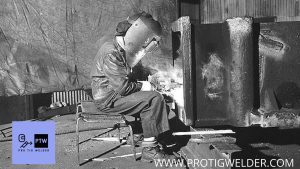TIG welding is one of the oldest and most popular methods, but when was TIG welding invented? TIG welding was invented in 1941 by John Beadle. John wanted to create a method that would produce less heat build-up while still maintaining the same level of structural integrity.
TIG welding became standard practice in 1946 and was handled by flat-rolled steel companies. It wasn’t until the 1960s that it began to be used more often for structural applications, including aircraft construction. After this time, TIG welding started being used more often for
The first patents for manual TIG welding go back to 1913. Manual TIG welding has not changed much since that time but became more efficient with the invention of programmable logic controllers (PLC) in the mid-1960s. Most high production vehicles today are made using TIG Welding including all Porsche vehicles, most Audi vehicles and most Mercedes-Benz vehicles. Many ancillary components for these vehicles are manufactured using the TIG welding method, as well. TIG welding is one of the most versatile welding methods and it’s no wonder why it has become so popular in recent times.
Steps To Using a TIG Welder
1. Safety is of utmost importance, so be sure to ground yourself before working with the tig welder.
2. Choose the proper size tig torch for your workpiece by matching it with your welding rod.
3. Position the tig torch against the weld joint and hold it in place using long strokes without touching any other surface or metal that isn’t grounded.
4. Heat should start to build upon the spot you’re welding and can be used as a visual indicator that you’re getting close to the desired temperature, but don’t overheat and exceed this threshold as this will cause wear and tear on both your tig welder and your metal pieces.
5. Once you reach the optimal temperature, immediately remove your tig torch and start to angle the welding rod so it begins to melt onto the metal surface.
6. Continue applying gentle but firm pressure onto the welding rod until a pool of molten metal forms on top of the weld joint
7. Remove any slag or excess material from the surface of your metal project when you’re done.
8. If any spatter occurs, it is very important to clean up all molten pieces from your work area before they harden so they do not pose a danger when walking through the shop.
Tips For Using a TIG Welder
TIG welding has been around for a long time, but it’s still used in various industries. It’s important to know how to use your tig welder to avoid damaging your equipment or even the metal that you’re working on. There are many tips for using a tig welder, but there are a few basic points that should be followed for the best results.
- Remember to always use the appropriate tungsten electrodes for your tig welding machine, as they each have different amperage requirements and ratings. This will prevent sparking of the electrode and may even protect or prolong the life of your welder or spool gun.
- Make sure that you keep your workpiece at a reasonable distance from the machine to avoid damage. The tungsten electrode should be kept between 1/8 and 3/16 of an inch away at all times. This will also ensure that the arc is focused correctly on the metal base, allowing for clean welding.
- Keep in mind that the welding arc is extremely hot and can burn through clothing or flesh on contact. Make sure to always wear protective clothing, such as gloves and a welding jacket, when working.
- Always keep the tungsten electrode properly shielded with the gas cup. This will prevent any flashback that could damage your equipment or vision. It’s also important to make sure that your gas cup is free of any debris, which could burn up and damage the electrode.
- TIG welding typically uses a pulse feature that can help to shield the weld pool from oxygen or other air contaminants. This will ensure that the weld remains clean and strong while increasing its overall strength. If you are having issues getting the arc started, be sure to check your pulse settings in order to adjust them and achieve the best possible results.
- You should also remember that TIG welding can be used in several different positions, including flat, horizontal or vertical. Make sure you keep the workpiece properly positioned throughout the welding process so that it doesn’t slip out of place. This will ensure a quality finished product.
- TIG welding is often used for high-quality projects, which require the utmost in precision and care. If you’re just interested in learning more about how it’s done or what it can do, remember to take your time when you get started. This should ensure that quality results are achieved each time.
“When Did TIG Welding First Come into Existence?”
TIG welding was invented in 1941 by John Beadle, who worked to develop a method that would produce less heat build-up while still maintaining the same level of structural integrity.
In the 1950s, Lincoln Electric began manufacturing TIG welding equipment for consumer use. It soon became a popular choice for welders of all skill levels.
In the 1960s, TIG welding became a common practice for hobbyists and enthusiasts, who enjoyed working with their new equipment.
In the 1970s, companies started implementing TIG welding as part of their regular work practices. It was most commonly used in fabrication shops to create a variety of products.
The Future of the TIG Welder Industry in the US and Abroad
The future for the Tig Welder industry in the US and abroad is unclear. While we see a lot of growth in other countries, we don’t see quite as much in the US. We’re hopeful that we’ll be able to sustain our growth and continue to grow steadily.
But as we all know, the US is facing a bit of an economic crisis right now and that could potentially affect our growth.
One thing we do see in other countries is government support for companies like ours. The economic crisis isn’t as deep and governments over there aren’t cutting budgets as much as they are here. We’re seeing other countries support their companies in much more aggressive ways than the US. The end result is that we’re seeing steady growth over there and, hopefully, it will continue to flow into our country as well


![What Is Friction Welding Process? | [Best Guide - PROTIGWELDER] What Is Friction Welding Process](https://protigwelder.com/wp-content/uploads/2022/01/What-Is-Friction-Welding-Process-150x150.jpg)
![What is Spot welding? And How Does It works? [PROTIGWELDER] what is spot welding](https://protigwelder.com/wp-content/uploads/2022/01/what-is-spot-welding-1-150x150.jpg)
![How to Weld Stainless Steel? [Complete Guide] | PROTIGWELDER How to Weld Stainless Steel](https://protigwelder.com/wp-content/uploads/2021/12/How-to-Weld-Stainless-Steel-1-150x150.jpg)
![How to Weld with Flux Core | [Ultimate Guide by PROTIGWELDER] how to weld with flux core](https://protigwelder.com/wp-content/uploads/2022/01/how-to-weld-with-flux-core-1-150x150.jpg)
![Yeswelder MIG-205DS Reviews [2022] | PROTIGWELDER Yeswelder MIG-205DS Reviews](https://protigwelder.com/wp-content/uploads/2022/01/Yeswelder-MIG-205DS-Reviews-150x150.jpg)
![How to Weld Cast Iron? [Ultimate Guide] | PROTIGWELDER How to Weld Cast Iron](https://protigwelder.com/wp-content/uploads/2021/12/How-to-Weld-Cast-Iron-1-150x150.jpg)
![How TIG Welding works? [Understanding of TIG Welding] How TIG Welding works](https://protigwelder.com/wp-content/uploads/2021/12/How-TIG-Welding-works-1-150x150.jpg)

![Difference Between TIG and MIG Welding? | [Update 2022] Difference Between TIG and MIG Welding](https://protigwelder.com/wp-content/uploads/2021/12/Difference-Between-TIG-and-MIG-Welding-1-150x150.jpg)
